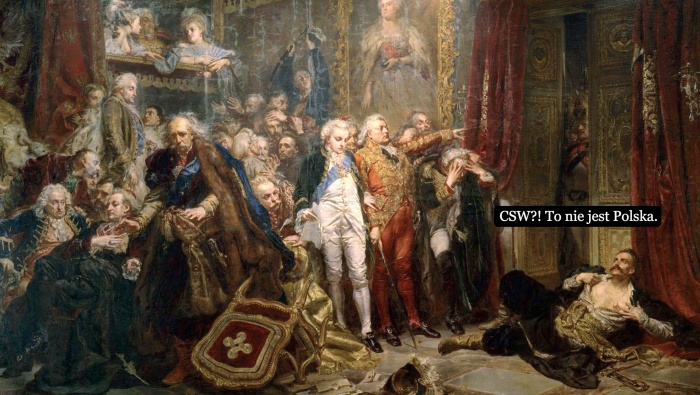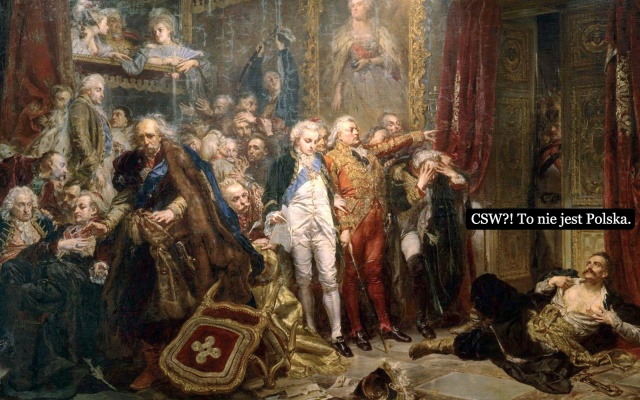The collective mental image of the capitalist world that developed in the Polish consciousness after the fall of the Iron Curtain portrayed a utopian realm of beauty and truth – a land with connotations of freedom, an American lifestyle and a full gamut of bright colors, in contrast to the greyness of the departing communism.This image of utopia stemmed from the-then overwhelming need to leave the past behind, to forget it and, at long last, live what Poles then optimistically referred to as a “normal life.” Very soon, however, reality bit, and turned out to be far less colorful than hoped for. Rampant privatization, multilayered poverty, a low wage policy that was there to stay and no thought given to civic society or social problems were just some of the problems that loomed. Those problems, swept under the carpet, now manifest themselves with a magnified intensity.
In Poland, a country that has seen many U-turns in its history, a country where the average income – lower even than that in Greece, permanently stuck in a crisis – is a reason for emigration – there is but a thin dividing line between national pride and an inferiority complex. Poland – until recently presented as a still-liberal “East European tiger” Poland, which sailed fairly intact through the economic crisis of 2008, in 2015 radically switched its course in the direction of a uniform, conservative vision pivoted on nationalism and Catholicism. A dearth of any neoliberal perception of capitalism coupled with almost no social thought completes the picture. Since 2015, the new Polish government has managed to enthrone Jesus Christ as the King of Poland (technically, by an ecclesiastical decision but with the compliance of the government), abolish the tripartite separation of powers by tampering with the status of the Constitutional Tribunal, muzzle politically the public media, facilitated the felling of a multitude of trees both in the oldest European primaeval forest and all over the country (by passing a new act of parliament known as Lex Szyszko) and set in motion the criminalization of abortion. These changes are disturbing; they have accentuated long-engrained social divisions and unleashed all manner of social upheaval.
In an interdisciplinary analysis, the third issue of “Obieg” takes on board new developments in the “national sensorium” and current attempts at creating “hybrid” forms of Polish identity and the practices of its transgression. This issue combines the perspective of researchers from Poland and abroad as well as specialists and commentators reflecting on the issue of Polish identity in relation to the conflict in Ukraine, the global immigration crisis and the proliferation of right-wing movements, in the context of human rights.
In the texts that we are presenting you will find strands of geopolitics, political fiction, collective memory and the “performativity” of mass protests. There is also a particular emphasis on the, newly empowered, voice of women – with a focus on how the roles that women play today and their associated narratives have functioned, both in the past and present discourse, both from the social-political and cultural point of view.
Interpreted as a configuration of characteristic national traits, the Polish identity is above all a form a social life – an ideological creation, employed as a means towards specific ends. In the perception of numerous commentators, the nation is not an “objective” value constructed around generalized criteria of a given community. Rather, it is close to Benedict Anderson’s “imagined communities”, which – in spite of their declared essentially conservative conviction that the nation is an immutable entity – are fully artificial constructs. The formula for Polish identity that is currently being sold will sooner or later find itself in confrontation with an ineradicable ambivalence: a constant paradigm, anchored in the language, as well as in the conscious and unconscious Polish mind, which is overlooked and does not altogether lend itself to elucidation. This is the “postmodern” track to follow if we take our cue from the exhibition Late Polishness: Forms of National Identity after 1989.
In our third issue, we deal with this ambivalence, proposing a sui generis atlas of the hybrid forms of Polishness, which is also our declaration of neutrality. This editorial direction is intended to seek communal spaces, analysing ways of standing up to the “Polish-Polish war” – setting out to transcend dogma, hang-ups, the group sense of culpability and all the stereotypes that presently thrive.
With this issue, we launch a new face of “Obieg”, with a re-arranged distribution of articles in the magazine, which will also now appear more frequently. We are looking forward to comments and suggestions from our readers. We have also added a new regular section – “info” – with stop-press style brief texts, notes and announcements to keep readers abreast of topical events in the world of art and culture, especially outside of Poland.
Translated by Anda MacBride

Sztuczne fiołki dla Obiegu, Jan Matejko, Rejtan – Upadek Polski (1866)



